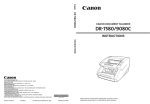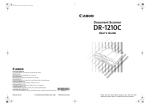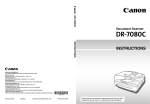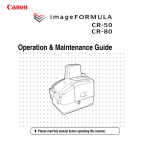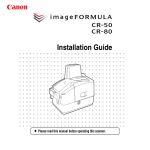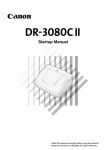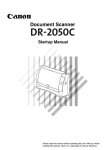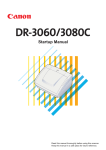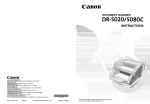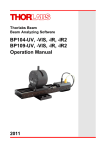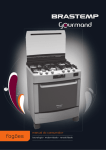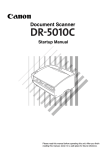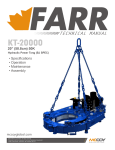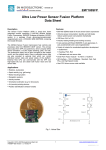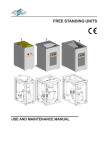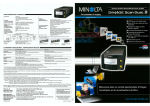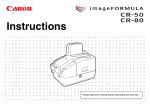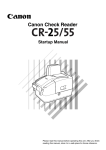Download Canon CR-180 Owner's Manual
Transcript
CANON CHECK READER
INSTRUCTIONS
CANON ELECTRONICS INC.
1248, SHIMOKAGEMORI, CHICHIBU-SHI, SAITAMA 369-1892, JAPAN
CANON U.S.A. INC.
ONE CANON PLAZA, LAKE SUCCESS, N.Y. 11042, U.S.A.
CANON CANADA INC.
6390 DIXIE ROAD, MISSISSAUGA, ONTARIO L5T 1P7, CANADA
CANON EUROPA N.V.
BOVENKERKERWEG 59-61, P.O.BOX 2262, 1180 EG AMSTELVEEN, THE NETHERLANDS
CANON LATIN AMERICA, INC.
703 WATERFORD WAY, SUITE 400 MIAMI, FLORIDA 33126, U.S.A.
CANON AUSTRALIA PTY. LTD.
1 THOMAS HOLT DRIVE, NORTH RYDE, SYDNEY. N.S.W, 2113. AUSTRALIA
CANON SINGAPORE PTE. LTD.
1 HARBOUR FRONT AVENUE #04-01, KEPPEL BAY TOWER, SINGAPORE 098632
CANON HONGKONG COMPANY LTD.
19TH FLOOR, THE METROPOLIS TOWER, 10 METROPOLIS DRIVE, HUNGHOM, KOWLOON, HONG KONG.
PUB.CE-IE-430-03M
0106ABXX
CANON ELECTRONICS INC. 2003
*CE-IE-430-03*
PRINTED IN JAPAN
Please read this manual before operating this unit. After you finish
reading this manual, store it in a safe place for future reference.
International ENERGY STAR® Office Equipment Program
As an ENERGY STAR® Partner, Canon Electronics Inc., has determined that this machine meets the
ENERGY STAR® Program guidelines for energy efficiency.
The International ENERGY STAR® Office Equipment Program is an international program that
promotes energy saving through the use of computers and other office equipment.
The program backs the development and dissemination of products with functions that effectively
reduce energy consumption. It is an open system in which business
proprietors can participate voluntarily. The targeted products are office equipment, such as computers, monitors, printers, fax, machine, copiers, and scanners. The standards and logos are uniform
among participating nations.
FCC REGULATIONS (For 120V models)
This equipment has been tested and found to comply with the limits for a Class A digital device, pursuant to Part 15 of the
FCC Rules. These limits are designed to provide reasonable protection against harmful interference when the equipment is
operated in a commercial environment. This equipment generates, uses, and can radiate radio frequency energy and, if not
installed and used in accordance with the instruction manual, may cause harmful interference to radio communications.
Operation of this equipment in a residential area is likely to cause harmful interference in which case the user will be
required to correct the interference at his own expense.
Do not make any changes or modifications to the equipment unless otherwise specified in the manual. If such changes or
modifications should be made, you could be required to stop operation of the equipment.
RADIO INTERFERENCE REGULATIONS (For 120V models)
This digital apparatus does not exceed the Class A limits for radio noise emissions from digital apparatus as set out in the
Interference-causing equipment standard entitled “Digital Apparatus”, ICES-003 of the Industry Canada.
RÈGLEMENT SUR LE BROUILLAGE RADIOÉLECTRIQUE (For 120V models)
Cet appareil numérique respecte les limites de bruits radioélectriques applicables aux appareils numériques de Classe A
prescrites dans la norme sur le matériel brouilleur: “Appareils Numériques”, NMB-003 édictée par l’Industrie Canada.
NOTICE
q Copyright 2003 by CANON ELECTRONICS INC. All rights reserved. No part of this publication may be reproduced, transmitted, transcribed, stored in a retrieval system, or translated into any language or computer language in any form or by any
means, electronic, mechanical, magnetic, optical, chemical, manual, or otherwise, without the prior permission of CANON
ELECTRONICS INC.
w The contents of this manual are subject to change without notice.
e Every effort has been made to ensure the accuracy of information presented in this manual. However, Canon Electronics Inc.
and the subsidiaries on the back cover assume no responsibility for any errors or their consequences.
r We do not assume any responsibility for damage resulting from operations regardless of item e.
Trademarks and Registered Trademarks
● Microsoft WindowsR and Microsoft Windows NTR are registered trademarks of Microsoft Corporation in the United States
and in other countries.
● ISIS is a trademark of EMC Corporation in the United States.
● Product names mentioned herein are for identification purposes only and may be trademarks and/or registered trademarks of
their respective companies.
READ CAREFULLY BEFORE OPENING THE SEALED DISK PACKAGE
CANON SOFTWARE LICENSE AGREEMENT
IMPORTANT-READ THIS AGREEMENT BEFORE OPENING THE SEALED DISK PACKAGE! BY OPENING THE
SEALED DISK PACKAGE, YOU ARE DEEMED TO AGREE TO BE BOUND BY THIS AGREEMENT.
This legal document is a license agreement between you and Canon Electronics Inc. ("Canon"). BY OPENING THE SEALED DISK
PACKAGE, YOU ARE DEEMED TO AGREE TO BE BOUND BY THE TERMS OF THIS AGREEMENT. IF YOU DO NOT AGREE TO THE
TERMS OF THIS AGREEMENT, DO NOT OPEN THE SEALED DISK PACKAGE AND PROMPTLY RETURN THE CANON SCANNER, THE
DISK PACKAGE CONTAINING SCANNER DRIVER SOFTWARE PROGRAMS AND/OR SCANNER UTILITY SOFTWARE PROGRAM
PROPRIETARY TO CANON OR ITS LICENSOR (THE "SOFTWARE") AND THE ACCOMPANYING DOCUMENTATION AND OTHER ITEMS
TO THE PLACE WHERE YOU OBTAINED THEM FOR A REFUND BEFORE THEY ARE USED OR OPENED OR UNPACKED.
In consideration of the right to use the SOFTWARE, you agree to abide by the terms and conditions of this Agreement.
1. GRANT OF LICENSE: Canon grants you the personal, non-exclusive right to use the SOFTWARE only on a single computer. You may
physically transfer the SOFTWARE from one computer to another provided that the SOFTWARE is used on only one computer at any time.
You shall not assign, sublicense, sell, rent, lease, loan, convey or transfer to any third party, or send or bring the SOFTWARE out of the country
where you originally obtain it to other countries without required authorization of applicable governments, or copy, duplicate, translate or convert to
another programming language the SOFTWARE or accompanying documentation, except as expressly provided herein.
Except as expressly permitted under the applicable law, you shall not alter, modify, disassemble, decompile or otherwise reverse engineer the
SOFTWARE or accompanying documentation and you also shall not have any third party to do so.
2. BACK-UP COPY: You may make one copy of the SOFTWARE solely for a back-up purpose or copy the SOFTWARE onto the permanent
storage device (e.g. a hard disk) of your computer and retain the original for a back-up purpose. Except as expressly permitted under the applicable law,
any other copying of the SOFTWARE is a violation of this Agreement. You must reproduce and include the copyright notice on the back-up copy.
3. SUPPORT AND UPDATE: Canon, Canon's affiliate, their distributor or dealer is not responsible for maintaining or helping you to use the
SOFTWARE. No updates, fixes or support will be made available for the SOFTWARE.
4. LIMITED WARRANTY AND DISCLAIMER OF INDEMNITY: Canon, Canon's affiliate, their distributor or dealer will not guarantee
uninterrupted service, or absence or correction of errors. Therefore, the SOFTWARE is licensed on an "AS IS" basis without warranty of any kind. The
diskette on which the SOFTWARE is recorded is warranted against defective material or workmanship under normal use for a period of ninety (90) days
from the date you purchased the same as evidenced by a receipt or otherwise. The limited warranty does not apply if the failure of the diskette resulted
from accident, abuse or misapplication of the SOFTWARE and shall not extend to anyone other than the original user of the SOFTWARE.
CANON, CANON'S AFFILIATE, THEIR DISTRIBUTOR OR DEALER DISCLAIMS ALL IMPLIED WARRANTIES, INCLUDING ANY
WARRANTY OF MERCHANTABILITY OR FITNESS FOR A PARTICULAR PURPOSE, WITH RESPECT TO THE SOFTWARE OR
ACCOMPANYING DOCUMENTATION.
NEITHER CANON, CANON'S AFFILIATE, THEIR DISTRIBUTOR NOR DEALER IS LIABLE FOR ANY LOSS OR DAMAGE
INCLUDING CONSEQUENTIAL OR INCIDENTAL LOSS OR DAMAGE SUCH AS LOSS OF PROFITS, EXPENSE OR INCONVENIENCE,
WHATSOEVER CAUSED BY OR ARISING OUT OF THE SOFTWARE, ACCOMPANYING DOCUMENTATION OR THE USE THEREOF.
CANON, CANON'S AFFILIATE, THEIR DISTRIBUTOR OR DEALER SHALL HAVE NO OBLIGATION TO INDEMNIFY YOU
AGAINST ANY CLAIM OR SUIT BROUGHT BY A THIRD PARTY ALLEGING THAT THE SOFTWARE, ACCOMPANYING
DOCUMENTATION OR THE USE THEREOF INFRINGES ANY INTELLECTUAL PROPERTY OF SUCH THIRD PARTY.
THE ABOVE IS CANON'S ENTIRE LIABILITY AND YOUR EXCLUSIVE REMEDY IN CONNECTION WITH THE SOFTWARE AND
ACCOMPANYING DOCUMENTATION.
5. TERM: This Agreement is effective upon opening the sealed disk package and remains in effect until terminated. You may terminate this
Agreement by destroying the SOFTWARE and any copy thereof. This Agreement will also terminate if you fail to comply with any of the terms of this
Agreement. In addition to Canon enforcing its respective legal rights, you must then promptly destroy the SOFTWARE and any copy thereof.
6. U.S. GOVERNMENT RESTRICTED RIGHTS NOTICE: The SOFTWARE is provided with RESTRICTED RIGHTS. Use, duplication or
disclosure is subject to restrictions as set forth in either subparagraph (c) (1) (ii) of the Rights in Technical Data and Computer Software clause at DFARs
252.227-7013 or subparagraph (c) (1) and (2) of the Commercial Computer Software Restricted Rights Clause at FAR 52.227-19, as applicable.
7. SEVERABILITY: In the event that provision of this Agreement is declared or found to be illegal by any court or tribunal of competent
jurisdiction, such provision shall be null and void with respect to the jurisdiction of that court or tribunal and all the remaining provisions of this
Agreement shall remain in full force and effect.
8. ACKNOWLEDGEMENT: BY OPENING THE SEALED DISK PACKAGE, YOU ACKNOWLEDGE THAT YOU HAVE READ THIS
AGREEMENT, UNDERSTOOD IT, AND AGREE TO BE BOUND BY ITS TERMS AND CONDITIONS. YOU ALSO AGREE THAT THIS
AGREEMENT IS THE COMPLETE AND EXCLUSIVE STATEMENT OF AGREEMENT BETWEEN YOU AND CANON CONCERNING THE
SUBJECT MATTER HEREOF AND SUPERSEDES ALL PROPOSALS OR PRIOR AGREEMENTS, VERBAL OR WRITTEN, AND ANY OTHER
COMMUNICATIONS BETWEEN YOU AND CANON RELATING TO THE SUBJECT MATTER HEREOF. NO AMENDMENT TO THIS
AGREEMENT SHALL BE EFFECTIVE UNLESS SIGNED BY A DULY AUTHORIZED REPRESENTATIVE OF CANON.
Should you have any questions concerning this Agreement, or if you desire to contact Canon for any reason, please write to Canon's local affiliate.
International ENERGY STAR® Office Equipment Program
As an ENERGY STAR® Partner, Canon Electronics Inc., has determined that this machine meets the
ENERGY STAR® Program guidelines for energy efficiency.
The International ENERGY STAR® Office Equipment Program is an international program that
promotes energy saving through the use of computers and other office equipment.
The program backs the development and dissemination of products with functions that effectively
reduce energy consumption. It is an open system in which business
proprietors can participate voluntarily. The targeted products are office equipment, such as computers, monitors, printers, fax, machine, copiers, and scanners. The standards and logos are uniform
among participating nations.
FCC REGULATIONS (For 120V models)
This equipment has been tested and found to comply with the limits for a Class A digital device, pursuant to Part 15 of the
FCC Rules. These limits are designed to provide reasonable protection against harmful interference when the equipment is
operated in a commercial environment. This equipment generates, uses, and can radiate radio frequency energy and, if not
installed and used in accordance with the instruction manual, may cause harmful interference to radio communications.
Operation of this equipment in a residential area is likely to cause harmful interference in which case the user will be
required to correct the interference at his own expense.
Do not make any changes or modifications to the equipment unless otherwise specified in the manual. If such changes or
modifications should be made, you could be required to stop operation of the equipment.
RADIO INTERFERENCE REGULATIONS (For 120V models)
This digital apparatus does not exceed the Class A limits for radio noise emissions from digital apparatus as set out in the
Interference-causing equipment standard entitled “Digital Apparatus”, ICES-003 of the Industry Canada.
RÈGLEMENT SUR LE BROUILLAGE RADIOÉLECTRIQUE (For 120V models)
Cet appareil numérique respecte les limites de bruits radioélectriques applicables aux appareils numériques de Classe A
prescrites dans la norme sur le matériel brouilleur: “Appareils Numériques”, NMB-003 édictée par l’Industrie Canada.
NOTICE
q Copyright 2003 by CANON ELECTRONICS INC. All rights reserved. No part of this publication may be reproduced, transmitted, transcribed, stored in a retrieval system, or translated into any language or computer language in any form or by any
means, electronic, mechanical, magnetic, optical, chemical, manual, or otherwise, without the prior permission of CANON
ELECTRONICS INC.
w The contents of this manual are subject to change without notice.
e Every effort has been made to ensure the accuracy of information presented in this manual. However, Canon Electronics Inc.
and the subsidiaries on the back cover assume no responsibility for any errors or their consequences.
r We do not assume any responsibility for damage resulting from operations regardless of item e.
Trademarks and Registered Trademarks
● Microsoft WindowsR and Microsoft Windows NTR are registered trademarks of Microsoft Corporation in the United States
and in other countries.
● ISIS is a trademark of Captiva Software Corporation in the United States.
● Product names mentioned herein are for identification purposes only and may be trademarks and/or registered trademarks of
their respective companies.
INTRODUCTION
Thank you for purchasing the Canon Check Reader CR-180.
Please read this manual thoroughly before operating the machine in order to
familiarize yourself with its capabilities, and to make the most of its many
functions. After reading this manual, store it in a safe place for future reference.
Conventions
This manual uses the following symbols and indications.
Before you start reading this manual, read and familiarize yourself with the
meanings of the symbols shown below.
WARNING
Warnings are provided for your safety and contain extremely important information.
Failure to observe the instructions provided in a warning could result in death or serious
injury to yourself or your co-workers.
CAUTION
Caution notices are also provided for your safety and contain important information.
Failure to observe the instructions provided in a caution notice could result in serious
injury to yourself or your co-workers or damage the equipment.
Important
These important notes contain important information on procedures that must be
followed or actions that must be avoided. Failure to observe a request, could result in
damage to the equipment or a malfunction.
Note
Notes provide additional tips or advice that can save you time and effort in using the
check reader.
1
CONTENTS
INTRODUCTION ..........................................................................................1
Conventions ................................................................................................ 1
Safety Precautions .....................................................................................5
Daily Maintenance ......................................................................................
Installation Location ....................................................................................
Power Supply ..............................................................................................
Carrying ......................................................................................................
Chapter 1
5
6
7
7
Introduction to the CR-180
1.1 Features of the CR-180................................................................... 10
1.2 Packaging: What Is in the Box? ......................................................12
1.3 Part Names ...................................................................................... 13
◆ Front View ............................................................................................. 13
◆ Rear View .............................................................................................. 14
◆ Connectors ............................................................................................ 14
Chapter 2
Preparation Before Use
2.1 Setting Up the Scanner ...................................................................16
2.2 Checking Your Operating Environment .........................................17
2.3 Installing the Software ................................................................... 19
Installing the Scanning Utility .................................................................... 19
Installing the ISIS/TWAIN Driver ............................................................... 21
2.4 Connecting the Scanner to a Computer ....................................... 23
USB Connections ..................................................................................... 23
SCSI Connections .................................................................................... 24
Connecting the Power Cord ...................................................................... 25
2.5 Turning ON and OFF the Power .................................................... 26
Turning ON the Power .............................................................................. 26
Turning OFF the Power ............................................................................ 28
2.6 Preparing the Ink Cartridge ............................................................29
About the Ink Cartridge ............................................................................. 29
Adjusting the Print Position ....................................................................... 29
2
Chapter 3
Software
3.1 How to Use the Software................................................................ 32
How to Use the Scanning Utility ............................................................... 32
How to Use the ISIS/TWAIN Driver .......................................................... 34
3.2 Uninstalling the Software................................................................35
Chapter 4
Document Feeding and Scanning
4.1 Documents ...................................................................................... 38
Types of Documents ................................................................................. 38
Placing Documents ................................................................................... 40
4.2 Document Feeding and Scanning ..................................................41
Scan Procedure ........................................................................................ 41
Manual Feeding (Bypass Mode) ............................................................... 44
Chapter 5
5.1
5.2
5.3
5.4
Troubleshooting
When the Scanner Is Not Recognized .......................................... 46
Clearing Paper Jams ...................................................................... 48
Feeding Trouble ...............................................................................50
When the Scanned Image Is Not Normal .......................................52
Chapter 6
Maintenance
6.1 Daily Cleaning ..................................................................................54
Cleaning the Main Unit .............................................................................
Cleaning the Scanning Glass and Rollers ................................................
Cleaning the Magnetic Heads ...................................................................
Cleaning the Ink Heads and Ink Absorber ................................................
54
55
58
60
6.2 Maintenance .....................................................................................63
Replacing the Ink Cartridge ...................................................................... 63
Adjusting the Separation Roller Gap ........................................................ 66
Specifications ...........................................................................................67
Scanner Specifications ............................................................................. 67
Exterior Dimensions .................................................................................. 68
Index ......................................................................................................... 69
3
Safety Precautions
Daily Maintenance
When you are working around the scanner, follow these precautions to avoid fire
and electrical shock.
WARNING
4
■ Never install and operate the scanner near flammable substances, such as alcohol,
paint thinner, benzene, or any other type of volatile solution.
■ Never damage or modify the power cord, and never place heavy objects on the power
cord.
■ Always make sure that your hands are dry when you are handling the power cord or
plug. Never grasp the plug when your hands are wet.
■ Never plug the scanner into a multiplug power strip.
■ Never bundle, wrap, or tie the power cord around itself or another object. Connect the
plug securely into the power source.
■ Use only the power cord and plug provided with the scanner.
■ Never attempt to disassemble or modify the scanner.
■ Never use flammable aerosol products near the scanner.
■ Before you clean the scanner, turn the power OFF and disconnect the power cord
from the power outlet.
■ To clean the scanner’s exterior, use a firmly wrung cloth, moistened slightly with
water or mild detergent. Never use any type of volatile solution, such as alcohol,
benzene or paint thinner.
■ If you hear strange sounds, detect smoke or abnormal heat, sense vibration, or smell
odd odors around the scanner, turn OFF the power switch immediately and
disconnect the power cord from the power outlet. Call for service immediately.
■ Handle the scanner with care. Avoid shocks and vibrations to the scanner caused by
reckless handling. If you suspect the scanner has been accidentally damaged, turn
OFF the power switch immediately and disconnect the power cord from the power
outlet. Call for service immediately.
■ Before you move the scanner, always turn OFF the power and disconnect the power
cord from the power outlet.
CAUTION
■ To avoid damage to the scanner, never place the scanner on an unstable or vibrating
surface. The scanner may tip or fall over, causing injury.
■ To avoid overheating and causing a fire, never block the air vents on the back of the
scanner.
■ Keep all liquids, beverages, or any type of liquid, and clips, staples, necklaces, or
other metal objects away from the scanner. If you accidentally spill liquid or drop a
metal object into the scanner, turn OFF the power immediately and disconnect the
power cord from the power outlet. Call for service immediately.
■ Never install the scanner in humid or dusty locations. Doing so may cause a fire or
electrical shock.
■ Never place heavy objects on top of the scanner. Such objects may tip or fall over,
and cause injury.
■ When you remove the power cord, grip it by the plug head. Never attempt to
disconnect the power cord from the power outlet by pulling on the power cord. Doing
so, may expose or break the core leads, damage the power cord, and cause a fire or
electrical shock.
■ Keep the area around the power outlet clear of all obstacles so you can disconnect
the power cord easily at all times.
■ Never spill water or volatile solutions (alcohol, benzene, paint thinner) into the
scanner. Doing so, may cause a fire or electrical shock.
■ When the scanner is not being used for a long time, disconnect the power cord from
the power outlet.
■ Avoid wearing loose fitting clothing, dangling jewelry, long ties, or even long hair that
could become entangled with moving parts, especially the rollers that feed paper into
the scanner. If such objects become entangled, immediately disconnect the power
plug from the power outlet to stop the scanner.
■ Be very careful when you are loading a document or clearing a paper jam. You may
be injured unexpectedly. For example, the paper edges may cut your fingers.
■ Do not open the maintenance cover while the scanner is operating. Doing so may
result in a malfunction or injury.
■ Do not directly touch the pins and contacts on the scanner connectors with your
hands. Doing so may result in a malfunction.
5
More than
5.9"
(150 mm)
More than 15.8" (400 mm)
More than 3.9" (100 mm)
More than 13.4" (340 mm)
Installation Location
More than 25.6" (650 mm)
For operation, maintenance and ventilation, make sure that there is enough space
around the scanner, as shown in the illustration above.
Avoid placing the scanner in the following places. It may cause a malfunction and
adversely affect the scanner or your computer.
• Places exposed to direct sunlight
If installation in such places is unavoidable, provide a curtain or similar object to
shade the scanner.
• Places subject to dust and fumes
Dust and cigarette fumes adversely affect the components inside the scanner.
• Near running water, a heat source, water vapor, or in an area, such as a
laboratory exposed to ammonia gas, paint thinner, or other volatile chemicals.
• Places subject to vibration and strong shock
• Places subject to rapid changes in temperature or humidity
Condensation occurring inside the scanner may impair image quality. Place the
scanner in a room that is well within the following range:
Room temperature:
50°F to 90.5°F (10°C to 32.5°C)
Relative humidity:
20% to 80% RH
Use the recommended operating environment for the ink cartridge when using
the imprinter.
• Near electronic equipment or heavy equipment that generates a strong
magnetic field, such as a speaker, TV, and radio
6
Power Supply
• Be sure to connect the scanner to an AC 220-240V (50/60 Hz) or AC 120V
(60 Hz) power supply, according to your region’s requirements.
• Make sure that the scanner is connected to an independent power outlet. Do not
plug the scanner into an outlet shared with another device. If you use an
extension cable, pay attention to the total amperage of the cable.
• If you are unsure of anything relating to the power supply, contact your dealer,
service representative, or your local power company.
• Never place an object on top of the power cord or step on the power cord.
• Never bundle the power cord or wrap the cord around an object, such as a table
leg.
• Do not tug on the power cord. When you remove the power cord, grip it by the
plug head.
• Keep the area around the power outlet free of obstacles.
Carrying
When you move the CR-180, hold it firmly with both hands and carry it carefully.
The scanner weighs approximately 13.9 lb (6.3 kg).
WARNING
When moving the scanner, be sure to turn OFF the power and remove any cables. If
the cables are not removed before moving the scanner, you may damage the plugs or
connectors by forcibly pulling them out.
7
Chapter 1
Introduction to the CR-180
This chapter describes the features of the
scanner, what comes packaged in the box,
and the names and functions of parts on the
scanner.
1.1 Features of the CR-180 ......................10
1.2 Packaging: What Is in the Box? ........ 12
1.3 Part Names ..........................................13
Front View ................................................ 13
Rear View ................................................ 14
Connectors .............................................. 14
Chapter 1
Introduction to the CR-180
Features of the CR-180
The Canon Check Reader CR-180 is a scanner with magnetic heads that can
read checks and other documents that are printed with MICR (Magnetic Ink
Character Recognition) compatible fonts and is capable of OCR (Optical
Character Recognition). The CR-180 is compact and can handle large volumes of
checks at a speed of 180 ppm.
Features
● High speed scanning
The CR-180 performs high-speed scans of check size documents at 180 ppm
(200 dpi resolution).
● Supports large documents
Documents up to 4.6" x 9.1" (118 mm x 230 mm) can be scanned.
● High durability
The scanner has a high durability of 24 million scans.
● Compact size
10.7" (H) x 15.7" (W) x 9.5" (D) (271 mm (H) x 399 mm (W) x 242 mm (D))
● Supports black-and-white (binary) and grayscale output
● Reads MICR characters
A magnetic head is used to scan MICR characters that have been printed with
magnetic ink or toner.
● Supports OCR (Optical Character Recognition)
Character images, such as E13B, OCR-A, OCR-B, and check writer are
recognized as characters by the OCR function.
● Easy to maintenance
Large maintenance covers make handling paper jams and cleaning easy.
● Jogger mechanism is standard
A jogger mechanism, which uses vibration to align documents, comes standard
equipped with the CR-180.
● Bypass mode
You can scan vouchers that contain two or more pages together as one
document without paper jams.
● Paper thickness adjustment mechanism
Adjust the separation roller gap to the thickness of the paper being fed.
10
1.1 Features of the CR-180
● Automatic separator mechanism
Scanned documents are automatically ejected to one of two pockets based on
separation conditions.
1
● Double feed detection
The scanner detects double fed documents.
● Drop out color
This function enables drop out scanning of a specific color in the document.
● Imprinter is standard equipment
An imprinter mechanism, to print text on documents as they are scanned,
comes standard equipped with the scanner. The imprinter’s ink cartridge is not
included, and must be purchased separately. (See “About the Ink Cartridge,”
on p.29.)
● Eject pocket full detection (Scanning Utility for CR-180)
Detects when the eject pocket is full and stops scanning. (See “Scan
Procedure,” on p.43.)
11
Chapter 1
Introduction to the CR-180
Packaging:
What Is in the Box?
Make sure that you have everything. Check every item you have removed from
the box. If any items are missing, contact your local authorized Canon dealer.
Document Feed Guide
CR-180
Jogger Support
Instructions (This Manual)
Warranty Card*2
Setup Disc
Power Cord*1
USB Cable
*1 The power cord varies according to the country of purchase.
*2 For the United States and Canada only.
12
1.3 Part Names
1
Part Names
This section describes the names and functions of each part. Before you connect
the CR-180, take a few minutes to familiarize yourself with the main parts and
their functions.
◆ Front View
Jogger Support
Top Cover
Use the jogger support if the stack
of documents exceeds the loading
limit mark. (See “Scan Procedure,”
on p.41.)
Document Brace
Document Feed Guide
Attach the document feed guide
to hold large document stacks in
place. (See “Scan Procedure,”
on p.41.)
Eject Stopper
Pull out the eject stopper to
prevent documents from falling
off the output tray.
Power Switch
Operation Buttons
Jog
Start
Separation Roller Gap
Adjustment Dial
Stop
Jog: Uses vibration to align the documents. (Jogger)
Start: Starts scanning operations.
Stop: Stops scanning operations.
Eject Pocket
Documents are separated with a
flapper into two pockets. (See p.43.)
Adjust the separation roller gap if
feeding errors occur too frequently.
(See “Adjusting the Separation
Roller Gap,” on p.66.)
Bypass (manual) Mode Button
Use this button when you want to scan
multiple documents continuously or
documents that stick together. (See
“Manual Feeding (Bypass Mode),” on
p.44.)
Scanner Unit
This unit scans the documents.
Ink Cartridge
Ink cartridge is not included.
Purchase the ink cartridge
separately. (See “About the Ink
Cartridge,” on p.29.)
Maintenance Cover
Open this cover to clear paper
jams or to clean the scanner.
Magnetic Head for MICR
Reads MICR characters that have
been printed with magnetic ink.
13
Chapter 1
Introduction to the CR-180
◆ Rear View
Power Cord Connector
Connect the power cord provided with
the scanner to this connector.
Connectors
CAUTION
Air Vent
To avoid overheating and causing a fire, never block the air vents on the back of the
scanner.
◆ Connectors
14
DIP switch
SCSI connector
USB connector
This switch is for setting the
SCSI ID. (See “Setting the
SCSI ID,” on p.24.)
Connect a half-pitch 50 pin
SCSI cable. (See “SCSI
Connections,” on p.24.)
Connect a Hi-Speed USB 2.0
compatible cable. (See “USB
Connections,” on p.23.)
Chapter 2
Preparation Before Use
This chapter describes how to prepare the
scanner to scan documents.
2.1 Setting Up the Scanner ......................16
2.2 Checking Your Operating
Environment ....................................... 17
2.3 Installing the Software .......................19
Installing the Scanning Utility................... 19
Installing the ISIS/TWAIN Driver ............. 21
2.4 Connecting the Scanner to a
Computer .............................................23
USB Connections .................................... 23
SCSI Connections ................................... 24
Connecting the Power Cord .................... 25
2.5 Turning ON and OFF the Power ........26
Turning ON the Power ............................. 26
Turning OFF the Power ........................... 28
2.6 Preparing the Ink Cartridge .............. 29
About the Ink Cartridge ............................ 29
Adjusting the Print Position ...................... 29
Chapter 2
Preparation Before Use
Setting Up the Scanner
Perform the following steps to set up the CR-180. Refer to the section for each
step for details about that step.
1. Check your operating environment (See “Checking Your Operating
Environment,” on p.17.)
d
2. Install the software (See “Installing the Software,” on p.19.)
Install the Scanning Utility provided with the CR-180.
d
3. Connect the scanner to a computer (See “Connecting the Scanner to a
Computer,” on p.23.)
You need to turn off the computer before connecting the CR-180 to it with a
SCSI cable.
d
4. Turn ON the power (See “Turning ON the Power,” on p.26.)
Turn on the CR-180 before turning on the computer if they are connected with
a SCSI cable.
d
5. Automatically installing the device driver (See p.27.)
The device driver is installed automatically when Windows recognizes the CR180.
Important
● To have the device drivers installed automatically when the computer recognizes the
CR-180, the software needs to be installed before the CR-180 is connected to the
computer.
● If you connect the computer and turn on the CR-180 before installing the software,
the following wizard appears. If this happens, click [Cancel] to close the wizard’s
window, turn off the CR-180 and then install the software.
Wizard Screen (Windows 2000)
16
2.2 Checking Your Operating Environment
Checking Your Operating
Environment
2
Your computer system must meet the following conditions to use the CR-180.
● IBM PC/AT or compatible machines that meet the following
specifications:
• Intel Celeron 733 MHz or faster
• 256 MB main memory or more (recommended)
• 100 MB or more free space on the hard disk
● One of the following operating systems:
• Microsoft Windows 2000 Professional SP4
• Microsoft Windows XP SP2
● Interface card
Use the Hi-Speed USB 2.0 interface that is standard on your computer or use
either the USB 2.0 interface card or the SCSI card recommended for the CR180.
Adaptec USB2.0 Interface Card (for PCI bus)
• USB2connect2000LP (AUA-2000)
• USB2connect3100 (AUA-3100LP)
• USB2connect5100 (AUA-5100)
Adaptec USB2.0 Interface Card (for Card bus)
• USB2connect for Notebooks (AUA-1420)
Adaptec SCSI Card (for PCI bus)
• AHA-2930U, AHA-2940AU, ASC-19160, ASC-29160
Adaptec SCSI Card (for Card bus)
• APA-1480
● Interface cable
Use the Hi-Speed USB 2.0 interface cable provided or purchase one
separately to connect the CR-180 and the computer via a USB interface.
To use the SCSI card for the connections, check the shape of the connector on
the SCSI card and use a SCSI cable with connectors that can be connected to
the scanner. The scanner’s SCSI connector is a half-pitch 50-pin (pin type)
connector.
● Monitor that can display a resolution of 1024 x 768 (XGA) or greater is
recommended.
● Either an ISIS (compatible) or a TWAIN (compatible) application that
operates on one of the operating systems noted above.
17
Chapter 2
Important
18
Preparation Before Use
● Use the latest USB 2.0 driver when using USB connections. Contact your local
retailer for details.
● Operation is not guaranteed for any USB interface that is standard equipment on a
computer. If the USB interface that is standard on your computer does not allow for
normal operations, use the Hi-Speed USB 2.0 interface card that is recommended.
● Use the USB cable provided or a cable that supports Hi-Speed USB 2.0.
● If the CPU, memory, SCSI card, or USB interface card does not meet the
recommended specifications, the scanning speed may slow down, or the time
required to transfer data may increase.
● Even if the computer satisfies the recommended specifications, the scanning speed
may be low depending on the scan settings.
● The ISIS/TWAIN driver provided may not operate with all ISIS compatible
applications or TWAIN compatible applications. For details, contact your local
software retailer.
2.3 Installing the Software
Installing the Software
The following software applications are provided on the setup disc that is
packaged with the scanner. Be sure to open and read the Readme.txt file on the
setup disc before installing the software.
2
● Scanning Utility
This utility software is a dedicated software application for the CR-180.
A dedicated scanner driver is installed after you install the utility software.
● ISIS/TWAIN driver
This scanner driver should be used with ISIS (Image and Scanner Interface
Specification) compatible or TWAIN (Technology Without Any Interested Name)
compatible software. Install it, only if it is required.
Important
● The Scanning Utility includes a device driver so that Windows can recognize the CR180. Be sure to install the Scanning Utility before connecting the CR-180 to the
computer.
● The ISIS/TWAIN driver provided with the scanner does not necessarily operate all
ISIS compatible or TWAIN compatible applications. Contact your software dealer or
service representative for further information.
● Some functions mentioned in this manual may not be operated in some applications.
Installing the Scanning Utility
Follow the instructions below to install the Scanning Utility and the dedicated
driver.
The dedicated scanner driver is installed after the Scanning Utility has been installed.
Note
1 Turn ON your computer, and log on to Windows.
Be sure to log on as the Administrator.
Important
19
Chapter 2
Preparation Before Use
2 Insert the setup disc into the CD-ROM drive.
This manual assumes that “D” is assigned to your CD-ROM drive.
3 Click [Start], and then select [Run].
The screen that appears depends on which Windows operating system
you are using.
4 Enter “D:\SU180\setup.exe” in the [Open] fields, and then click
[OK].
Installation starts.
20
2.3 Installing the Software
5 Follow the instructions on the screen to complete the installation.
Important
● The computer may need to be restarted, depending on the operating system, after the
installation. If this is necessary, be sure to restart the computer.
2
Installing the ISIS/TWAIN Driver
Connect the scanner to your computer.
Important
● If another ISIS compatible driver is already installed on the computer, be sure to
make a backup of the following file. The content of this file may be overwritten when
the ISIS/TWAIN driver is installed.
Windows 2000
C:\WINNT\System32\Pix*.dll
C:\WINNT\Pixtran\*.*
Windows XP
C:\Windows\System32\Pix*.dll
C:\Windows\Pixtran\*.*
1 Turn ON your computer, and start Windows.
Be sure to log on as the administrator.
Important
2 Insert the setup disc into the CD-ROM drive.
This manual assumes that “D” is assigned to your CD-ROM drive.
21
Chapter 2
Preparation Before Use
3 Click [Start], and then select [Run].
The screen the appears depends on which Windows operating system
you are using.
4 Enter “D:\Driver\setup.exe” in the [Open] field, and then click [OK].
Installation starts.
5 Follow the instructions on the screen to complete the installation.
Important
22
● The computer may need to be restarted, depending on the operating system, after the
installation. If this is necessary, be sure to restart the computer.
2.4 Connecting the Scanner to a Computer
Connecting the Scanner to
a Computer
2
There are two ways to connect the scanner to your computer; SCSI or USB. Use
the method that is compatible with your computer system.
CAUTION
■ Do not turn OFF the scanner or remove any interface cables when an application is
running.
■ Do not connect both SCSI and USB interface cables at the same time.
■ Turn OFF the computer and the scanner before changing the cable.
USB Connections
Connect the scanner and the computer with the cable provided or a Hi-Speed
USB 2.0 cable.
Type A plug
Type B plug
USB Cable
SCSI Connector
(cannot be connected)
Note
USB Connector
Connect the type B plug (square) to the scanner and connect the type A plug (flat) to
the USB port on the computer.
23
Chapter 2
Preparation Before Use
SCSI Connections
Turn off the computer and then connect the scanner and the computer with the
SCSI cable.
SCSI Cable
SCSI Connector
Half-pitch 50-pin
(pin type)
Important
USB Connector
(cannot be connected)
Be sure to turn off the power to the scanner and the computer before connecting the
SCSI cable.
◆ Setting the SCSI ID
Set the SCSI ID using the DIP (Dual Inline Package) switch located on the left
side of the SCSI connector.
Push the DIP switches down to turn them ON, and push them up to turn them
OFF. Refer to the following table to set the SCSI ID using the DIP switches.
DIP Switches
Important
24
● The SCSI ID default is set to 2. Be careful not to set the same SCSI ID as other SCSI
devices that are mounted internally or connected to the computer.
● Disable the terminator on any SCSI device that might be connected between the
scanner and the computer.
2.4 Connecting the Scanner to a Computer
Connecting the Power Cord
Connect the power cord.
Be sure to use only the power cord provided with the scanner.
2
WARNING
When connecting the power cord, follow these precautions. Failure to do so may cause
a fire or electrical shock.
■ Never grasp the plug when your hands are wet.
■ Never plug the scanner into a multiplug power strip.
■ Never bundle or tie the power cord around itself or another object. Connect the plug
securely into the power source.
■ Use only the power cord and plug provided with the scanner.
■ Before you connect the power cord, be sure to turn OFF the power switch.
■ Be sure to connect the scanner to an AC 220-240V (50/60 Hz) or AC 120V (60 Hz)
power supply, according to your region’s requirements.
■ Do not plug the scanner into an outlet shared with another device. If you use an
extension cable, pay attention to the total amperage of the cable.
25
Chapter 2
Preparation Before Use
Turning ON and OFF the Power
Follow the procedures below to turn the scanner power ON and OFF.
Turning ON the Power
Important
Be sure to turn the power of all connected SCSI devices ON before you turn the computer
ON.
1 To turn ON the scanner, press the power switch.
Jog
Start
Stop
ON
Important
WARNING
● The LED above the Start button, flashes after you turn the power ON for a few
seconds, then it remains lit.
● The eject pocket document sensor may make an incorrect detection when
scanning starts if a bright outside light or fluorescent light is shining on the
scanner’s eject pocket when the scanner is turned on. If this happens, pull the
flapper on the eject pocket all the way forward and then return it to cancel the
incorrect full detection and then try scanning again. (See p. 44)
● If the scanner does not work, or the LED continues to flash, there is a problem
with the scanner. Turn OFF the power, and contact your local retailer or a Canon
service department.
If you hear strange sounds, detect smoke or abnormal heat, sense a vibration, or
smell odd odors around the scanner, turn OFF the power immediately and
disconnect the power cord from the power outlet. Call for service immediately.
Failure to do so, may cause a fire.
2 Turn ON your computer.
26
2.5 Turning ON and OFF the Power
3 Windows recognizes the CR-180 as new hardware, and installation
starts automatically.
2
(Windows 2000)
(Windows XP)
Note
● The installation finished message is not displayed in Windows 2000.
● If your operating system is Windows XP, a message appears after the device driver is
installed.
● The CR-180 will be registered as “CANON CR-180 SCSI” or “CANON CR-180 USB”
in the Imaging Device directory.
The displayed device name of the CR-180 differs depending on the connection, via
SCSI or USB. Turn OFF the power to the scanner and the computer before changing
the connections, and then turn ON the power, and let the computer recognize the
scanner again.
27
Chapter 2
Preparation Before Use
Turning OFF the Power
Important
Turn OFF the power to the computer if you are using a SCSI cable to connect the
scanner.
1 Turn OFF your computer.
2 To turn OFF the scanner, press the power switch.
OFF
CAUTION
28
■ Wait at least 10 seconds before turning the scanner back ON.
■ For your safety, disconnect the power plug from the power outlet if you are not
using the scanner for a long period of time.
2.6 Preparing the Ink Cartridge
Preparing the Ink Cartridge
This section describes how to prepare the ink cartridge so that you can use the
imprinter to print text on scanned documents.
2
About the Ink Cartridge
The ink cartridge is not included with the scanner. Purchase an ink cartridge
separately, as shown below.
Compatible ink cartridges: Hewlett Packard ink cartridge, model numbers C6602B
(blue), C6602G (green), C6602R (red)
For details on installing the ink cartridge, see “Replacing the Ink Cartridge,” on p.63.
Note
Adjusting the Print Position
You can adjust the print position to three different levels.
1 Remove the top cover.
2 Press the open button, and pull the maintenance cover open to the
right and left.
29
Chapter 2
Preparation Before Use
3 Squeeze the print position adjustment lever and lift up to adjust the
print position.
Note
● Adjust the position of the text so that it aligns with the adjustment line on the print
position adjustment lever.
● The value of the adjustment line indicates the distance from the bottom edge of
the document to the center of the text.
Adjustment Line
Top:
1.6" (40 mm) from the bottom
edge of the document
Middle:
1.4" (36 mm) from the bottom
edge of the document
Bottom:
1.3" (32 mm) from the bottom
edge of the document
4 Close the maintenance cover in the order shown in the diagram
below.
5 Carefully replace the top cover.
If the top cover is not firmly in place, the ink cartridge is not installed properly.
Check the ink cartridge.
30
Note
Chapter 3
Software
This chapter describes how to install and use
the scanning software, Scanning Utility, and
ISIS/TWAIN driver.
3.1 How to Use the Software ...................32
Starting and Closing the Scanning
Utility ........................................................ 32
How to Use the ISIS/TWAIN Driver ......... 34
3.2 Uninstalling the Software ................. 35
Chapter 3
Software
How to Use the Software
This section describes how to start up the Scanning Utility so that you can use the
scanner. Read the Help files for both the Scanning Utility and the ISIS/TWAIN
Driver for information on how to use them.
How to Use the Scanning Utility
This section describes the procedure for using the Scanning Utility. Read the
[Help] file in [Scanning Utility] for more information.
1 Click [Start], point to [Programs], then click [Scanning Utility for
CR-180].
Click [All Programs], then [Scanning Utility for CR-180] if your Operating
System is Windows XP.
2 Start the Scanning Utility.
32
3.1 How to Use the Software
Note
The basic operation of the Scanning Utility is noted in the Scanning Utility help file.
On the [Help] menu, click [Help] to view the explanation.
3 Select [Scanner Setting] from the [File] menu.
3
The Settings dialog box appears.
4 Set the scan conditions and click [OK].
Note
For information about the settings for the scan conditions, click [Help] on the
Settings dialog box to open the Help file.
33
Chapter 3
Software
5 Select the scanning method from the [File] menu and start
scanning.
6 When scanning is finished, click [Exit] on the [File] menu to quit
the Scanning Utility.
How to Use the ISIS/TWAIN Driver
The explanation on how to use the ISIS/TWAIN driver is in the ISIS/TWAIN driver
help file. To view the help file, click [Start] point to [Programs], click [Canon
Document Scanner], and then click [Canon CR-180 Help].
34
3.2 Uninstalling the Software
Uninstalling the Software
This section describes how to uninstall the Scanning Utility and ISIS/TWAIN
driver.
Important
● Be sure to log on as the Administrator.
● The dialog boxes and button names in Windows XP are different from the ones used
in this manual. Refer to the Windows XP “Help and Support Center” to uninstall the
software.
1 Click [Start], point to [Settings] and click [Control Panel].
3
2 Double-click the [Add/Remove Programs] icon.
The [Add/Remove Programs Properties] dialog box appears.
35
Chapter 3
Software
3 Select the software that you want to remove from the list in the
dialog box, and then click [Add/Remove].
Important
● If you uninstall the “Scanning Utility for CR-180” you also need to uninstall the “Canon
Driver for CR-180.”
● If you uninstall the ISIS/TWAIN driver, select the “Canon CR-180 ISIS/TWAIN Driver.”
4 The [Confirm File Deletion] dialog box appears.
If you selected “Canon CR-180 ISIS/TWAIN Driver,” the above dialog box appears.
5 Click [Yes], and the uninstaller starts.
Follow the instructions on the screen to finish uninstalling the software.
36
Chapter 4
Document Feeding and
Scanning
This chapter describes precautions regarding
documents that can be handled on this
scanner and scanning operations.
4.1 Documents ..........................................38
Types of Documents ................................ 38
Placing Documents .................................. 40
4.2 Document Feeding and Scanning .....41
Scan Procedure ....................................... 41
Manual Feeding (Bypass Mode) .............. 44
Chapter 4
Document Feeding and Scanning
Documents
This section describes the types of documents that can be used and how to place
them.
Treat the documents carefully. The paper edges may cut your fingers.
CAUTION
Types of Documents
The CR-180 can feed a wide variety of
Length
document sizes. The ranges of width and
length for a document are:
Hight
: 2.4" to 4.6" (60 to 118 mm)
Length
: 4.7" to 9.1" (120 to 230 mm)
Thickness : 0.003" to 0.008" (0.08 to 0.20 mm)
Weight
: 17 to 40 lb bond (64 to 157 g/m2)
* For details on paper thickness when using infrared double feed detection
function, see p.39.
Hight
Follow these guidelines when you prepare a document for scanning:
• Before scanning documents that contain pasted artwork, make sure that the ink
or paste is thoroughly dry. If the documents are scanned with wet ink or paste,
the inside of the scanner may become dirty and it may cause a malfunction.
• If you scan a document written in pencil, the letters may not be scanned
properly or the pencil may rub off onto the rollers and stain subsequent
documents. Before you scan this kind of document, make a copy and then scan
the copy. After scanning a document written in pencil or some other soft writing
material, be sure to clean the scanning rollers. (See “Cleaning the Scanning
Glass and Rollers,” on p.55.)
• If you scan thin paper in the Duplex mode, the ink printed on the back side may
be scanned. If this happens, adjust the scanning density.
• Scanning documents with a rough surface may not feed easily, and may cause
friction between the documents, resulting in a feeding error. If this happens, feed
the documents one by one.
• Documents with glossy finish or colored background may cause false double
feed detections when using the infrared double feed detection function. If false
detections happen too often, disable the double feed detection function. (See
“Using Infrared Double Feed Detection,” on p.39.)
• To avoid paper jams, damage to documents, and a scanner malfunction, do not
feed the following types of paper into the scanner. If you want to scan these
types of paper, first make a copy and then scan the copy.
38
4.1 Documents
Note
Wrinkled or creased paper
Carbon backed paper
Curled paper
Coated paper or fax recording paper
Torn paper
Extremely thin paper
Paper with clips or staples
Paper with binding holes
● Note that mixing documents of different thickness and size may cause a malfunction
during feeding.
● Curled, wrinkled, or folded documents may cause an error. If this happens, straighten
out the curls, or reduce the number of documents loaded.
● Documents containing text or pictures within 0.2" (5 mm) of its edges, or documents
with a color background, may cause errors in automatic size detection.
4
Using Infrared Double Feed Detection
One of the double feed detection functions that the scanner is equipped with uses
the penetration of infrared light to detect when two or more documents are fed at
the same time.
Documents with glossy finish or colored background may cause false double feed
detections when using the infrared double feed detection function. If false
detections happen too often, disable the double feed detection function.
Also, the thickness of the documents should be from 0.004” to 0.005” (0.1 mm to
0.14 mm) to use the infrared double feed detection function. Please note that
double feed detection cannot be detected for thicker or thinner documents.
Note
● The Scanning Utility provided includes a specialized driver for the infrared double
feed detection function. The infrared double feed detection function cannot be used
with ISIS/TWAIN compatible applications used with the ISIS/TWAIN driver.
● Besides infrared light, the double feed detection function also uses document length
and thickness to detect if two or more documents are fed at the same time. However,
they are different from the double feed detection functions that can be used with the
specialized Scanning Utility driver and ISIS/TWAIN driver. Refer to the Help files for
the various applications for details.
39
Chapter 4
Document Feeding and Scanning
Placing Documents
Note the following points when placing documents on the scanner.
● Place the front of the document toward you.
● Do not exceed the load limit mark when placing documents in the
document tray. This may cause feeding errors or paper jams.
Load Limit Mark
● A maximum of 200 documents can be loaded at one time.
● Each eject pocket can hold the same number of documents as the
document tray. Remove the documents in the eject pockets before
scanning a different document.
● If you place long documents, move the stopper to the edge of the
document in the document tray. Otherwise, this may cause a paper eject
error.
Stopper
40
4.2 Document Feeding and Scanning
Document Feeding and Scanning
This section describes how to load and scan documents.
CAUTION
■ Avoid wearing loose fitting clothing, dangling jewelry, long ties, or long hair that could
become entangled with moving parts, especially the rollers that feed paper through
the scanner. If such objects become entangled, immediately disconnect the power
plug from the power outlet.
■ Check the paper stack and remove all clips, staples, pins, or any other type of metal
or plastic fastener. These objects may cause damage to the document, a paper jam,
or a scanner malfunction.
■ Do not touch anything except the operation buttons when the jogger is operating or
documents are being fed (See p.42.)
■ Do not touch documents that are being fed under any circumstances. The documents
that are being fed may cut your hand.
Scan Procedure
4
1 Carefully align the edges of the document.
2 Place the first page of the document facing you, and place the
leading edge of the document into the scanner.
41
Chapter 4
Document Feeding and Scanning
3 If the documents are not aligned, press [Jog].
The jogger mechanism can be used to align documents.
Jog
Important
Note
Start Stop
If you press [Jog] when a batch of documents of various sizes are loaded, the
alignment will be incomplete, and the documents will not be scanned in the order
loaded. If you are scanning documents of various sizes, align the leading edges of
all the documents with the entry point of feeding.
● The jogger vibrates for 10 seconds and then stops. Press one of the operation
buttons to stop the jogger.
● If the documents are large, the documents may fall over while they are vibrating.
If this happens, attach the jogger support to prevent the documents from falling
over.
Jogger Support
4 Instruct scanning to start from the software application.
Note
42
If the feed setting in the software application is “Panel-Feeding”, press [Start] to
start scanning.
4.2 Document Feeding and Scanning
5 Scanning starts.
Note
● If the documents are large, the documents may fall over while they are being fed.
If this happens, attach the document feed guide to prevent the documents from
falling over.
Document Feed Guide
● If “Sort Method” is set in the software application, the document will be ejected to
one of the two eject pockets according to the separation conditions that have
been set.
4
Flapper
Separates documents
Eject Pocket 1
Eject Pocket 2
● When printing with the imprinter, ink may get on the leading edge of the
document because the documents are ejected onto the printed surface.
Ink residue
Printed text (back side)
43
Chapter 4
Document Feeding and Scanning
Note
● When Using the Accompanying Scanning Utility for CR-180:
Scanning is suspended and a message is displayed when the eject pocket
becomes full of documents. Scanning resumes when the documents are
removed from the eject pocket (Eject pocket full detection).
● If you start scanning and the message shown above appears when there are no
documents in the eject pocket, pull the document brace all the way forward and
then return it to cancel the message and then try scanning again. (See “Turning
on the Power” on p. 26)
Document Brace
Manual Feeding (Bypass Mode)
Use the Bypass (manual) mode to scan duplicate forms which have sticky edges
or documents that have a rough surface. Feed these documents one by one and
press Bypass Mode button.
Bypass Mode Button
For duplicate forms, load the side with the sticky edges toward the feeding entry point.
Important
44
Chapter 5
Troubleshooting
This chapter describes the problems that
might occur in the CR-180, and how to
remedy them.
5.1 When the Scanner Is Not
Recognized .........................................46
5.2 Clearing Paper Jams ..........................48
5.3 Feeding Trouble ................................. 50
5.4 When the Scanned Image Is Not
Normal ................................................ 52
Chapter 5
Troubleshooting
When the Scanner Is Not
Recognized
The following causes and remedies describe why your computer may not
recognize the scanner.
Cause
Remedy
The Scanning Utility is not installed.
Install the Scanning Utility before connecting the scanner to the
computer. (See “Setting Up the scanner,” on p.16.)
Cause
Remedy
The scanner is not correctly connected to the computer.
Connect the scanner to the computer correctly. (See “Connecting the
Scanner to a Computer,” on p.23.)
Cause
Remedy
The scanner is turned off.
Turn on the scanner. However, if you are using SCSI connections, turn
off the computer and then turn on the scanner and then turn the
computer back on. (See “Turning ON and OFF the Power,” on p.26.)
Cause
Remedy
Interface card is incorrectly installed to the computer.
Refer to the user’s guide for the interface card and correctly install the
interface card to the computer. Also, make sure that Windows
recognizes the interface card according to the operating system you
are using. (See “Setting Up the Scanner,” on p.16.)
Cause
The USB interface provided as standard with your computer is
not compatible with the scanner.
Use the recommended USB 2.0 interface card. (See “Checking Your
Operating Environment,” on p.17.)
Remedy
Cause
Remedy
Cause
Remedy
46
USB cable is not compatible with the scanner (when using USB
connections).
Use the USB cable provided with the scanner. (See “Checking Your
Operating Environment,” on p.17.)
USB hub is not compatible with the scanner (when using USB
connections).
Remove the USB hub to use the scanner. (See “Checking Your
Operating Environment,” on p.17.)
5.1 When the Scanner Is Not Recognized
Cause
Remedy
Cause
Remedy
Cause
Remedy
The same SCSI ID is used for other SCSI devices (when using
SCSI connections).
Check the SCSI ID of all connected SCSI devices, and make sure that
the same SCSI ID is not set for two or more devices. Reset the SCSI
IDs if the same SCSI ID is set. (See “Setting the SCSI ID,” on p.24.)
Another SCSI device is valid as a terminator (when using SCSI
connections).
Cancel the SCSI device terminator that is connected between the
CR-180 and the computer. The CR-180 must be at the end of the
daisy chain, and all other SCSI devices in between the computer and
CR-180 must their terminators OFF. (See “Setting the SCSI ID,” on
p.24.)
The scanner was turned ON after turning ON the computer (when
using SCSI connections).
Turn the computer and scanner OFF, turn ON the scanner, and then
turn ON the computer. (See “Turning ON and OFF the Power,” on
p.26.)
5
47
Chapter 5
Troubleshooting
Clearing Paper Jams
If paper has jammed, open the maintenance cover and remove the jammed
paper.
CAUTION
■ Be careful when you clear a paper jam. You may be injured unexpectedly. For
example, the paper edges may cut your fingers, or the document may be damaged.
■ Remove all jammed sheets of paper. Paper scraps left inside the scanner may cause
a paper jam or malfunction.
1 Remove the top cover.
2 Press the open button, and pull the maintenance cover open to the
right and left.
3 Remove the paper that has jammed.
48
5.2 Clearing Paper Jams
4 Close the maintenance cover in the order shown in the diagram
below.
5 Carefully replace the top cover.
5
49
Chapter 5
Troubleshooting
Feeding Trouble
If the document is not fed properly or the detection functions do not work properly,
remedy the problem by checking the following conditions.
Condition
A paper jam has occurred.
Cause and Remedy
• Check to make sure that the size and thickness of the
document are within the supported range of the scanner,
and if the quality of the paper is appropriate.
For cautions on handling documents, see “Documents,”
on p.38.
• Documents with rough surfaces may cause a paper feed
error to occur.
Scan one sheet at a time in the Bypass (manual) mode.
(See “Manual Feeding (Bypass Mode),” on p.44.)
• Dirty or worn rollers inside the scanner may cause a
paper jam.
Clean the rollers if they are dirty. (See “Cleaning the
Scanning Glass and Rollers,” on p.55.) Worn rollers
must be replaced. Contact your dealer or Canon service
representative.
• The separation roller gap is too wide. Adjust the
separation roller gap. (See “Adjusting the Separation
Roller Gap,” on p.66.)
Condition
Cause and Remedy
50
A double feed error occurred even though documents
are not being double fed.
A double feed error may occur when documents with
different thicknesses are mixed. Turn off the double feed
detection mode, if this happens.
5.3 Feeding Trouble
Condition
Cause and Remedy
MICR characters are not recognized correctly.
• The scanner cannot correctly read MICR characters if
the magnetic heads are dirty. Clean the MICR magnetic
heads. (See “Cleaning the Magnetic Heads,” on p.58.)
• If MICR characters cannot be recognized correctly after
cleaning the heads, the MICR heads may be worn.
Contact your dealer or Canon service representative.
• The MICR text is on the back of the document. Load the
side with the MICR characters face up in the document
tray.
Other Causes
• Some of the MICR characters are scratched or missing.
Splattered MICR ink or toner may also be the problem.
Condition
The imprinter is not printing correctly (missing imprint
dots).
Ink is clogged in the ink jet nozzle. Clean the ink jet nozzle.
Cleaning the ink jet nozzle is recommended before using
the CR-180. (See “Cleaning the Ink Heads and Ink
Absorber,” on p.60.)
Cause and Remedy
Condition
Cause and Remedy
Documents get dirty when using the imprinter.
Ink from the imprinter has been placed on the feed path.
Clean the ink off the feed path. (See “Cleaning the Ink
Heads and Ink Absorber,” on p.60.)
5
51
Chapter 5
Troubleshooting
When the Scanned Image
Is Not Normal
If there is a problem with the scanned image (the image is not sharp or stripes
appear), one of the following conditions may be a probable cause. Check the
following conditions, and take the appropriate action.
● The scanning glass or rollers are dirty.
If the scanning glass or rollers are dirty, the dirt will appear on the scanned
image.
➝ Clean the scanning glass and rollers. For details, see “Daily Cleaning,”
on p.54.
● The scan conditions are inappropriate.
If the scan conditions are inappropriate, the scanned image will not be sharp or
will appear as dark.
➝ Check the brightness and other scanner settings.
If the scanned image is blurry or the document has not been scanned at all,
the brightness may be set too high.
If the scanned image appears dark, the brightness may be set too low.
Also, check the settings on the driver and the software application.
● The driver or application does not run correctly.
If the document cannot be scanned correctly even if the scan conditions are
adjusted, the driver or the application may not be functioning correctly.
➝ Reinstall the driver or application.
For details on how to install the driver, see “Installing the Software,” on p.19.
For details on how to install the application, see the applications instruction
manual.
● Other Causes
Even if the computer may be recognizing the scanner correctly, and the driver
and the application is installed correctly, scanning may not be performed
correctly. If this happens, the interface card is not compatible. Use the
recommended interface card.
If the above remedies do not rectify the problem, contact your dealer or a Canon
service representative.
52
Chapter 6
Maintenance
This chapter describes how to clean and
maintain the scanner.
6.1 Daily Cleaning .................................... 54
Cleaning the Main Unit ............................
Cleaning the Scanning Glass and
Rollers ......................................................
Cleaning the Magnetic Heads .................
Cleaning the Ink Heads and Ink
Absorber ..................................................
54
55
58
60
6.2 Maintenance ....................................... 63
Replacing the Ink Cartridge ..................... 63
Adjusting the Separation Roller Gap ....... 66
Chapter 6
Maintenance
Daily Cleaning
To ensure high-quality image scanning, regularly clean your CR-180 as described
below.
CAUTION
■ Before you clean the scanner, turn OFF the scanner and computer, and disconnect
the power cord from the power outlet. Otherwise, it may cause an electrical shock.
■ Never clean the scanner with any kind of organic solvent, such as alcohol, benzene,
or paint thinner. This may cause a fire and electrical shock, or cause the exterior of
the scanner to disfigure or disclolor.
■ Never spray mild detergent or water directly on the scanning glass. The spray could
penetrate below the glass and contaminate the internal light source and lenses.
Cleaning the Main Unit
Wipe the scanner with a firmly wrung cloth, moistened slightly with water or mild
detergent. Then, wipe off with a clean, dry cloth.
54
6.1 Daily Cleaning
Cleaning the Scanning Glass and Rollers
If stripes appear on scanned images or if dirt appears on scanned documents,
clean the scanning glass or rollers. Clean the scanning glass and rollers regularly.
1 Remove the top cover.
2 Press the open button, and pull the maintenance cover open to the
right and left.
Important
6
If you notice paper dust in the feed path when you open the maintenance cover,
clean it out with a cotton swab.
55
Chapter 6
Maintenance
3 Spin the rollers while wiping them clean with a firmly wrung cloth
dampened with water or a mild detergent.
There are 14 roller positions, as shown in the diagram below.
Scanning Unit
Note
● Use cotton swabs to clean the rollers in locations that are too narrow for your
fingers.
● Rollers in positions o to !3 are turned by the roller in position !4. Turn the roller
in position !4 to wipe the rollers.
● Open the scanning unit to clean the rollers in positions u to !2.
4 Push down the lock lever to release the lock on the scanning unit
(q), and then open the scanning unit (w).
Scanning Glass
(two sides)
Lock Lever
5 Use cotton swabs that are commercially available to clean the
entire scanning glass.
56
6.1 Daily Cleaning
6 Carefully close the scanning unit.
When closing the scanning unit, you will hear a click when it is
completely closed.
Lock Lever
7 Close the maintenance covers in the order shown in the diagram
below.
8 Carefully replace the top cover.
6
Important
If paper jams and double feeds (two papers being fed at the same time) still occur
after cleaning the rollers, the rollers may be worn. The rollers need to be changed.
Contact your local dealer or a Canon service representative.
57
Chapter 6
Maintenance
Cleaning the Magnetic Heads
If the magnetic heads are dirty, then MICR characters cannot be scanned
correctly. Periodically, clean the magnetic heads with a commercially available
audio head cleaner.
1 Press the open button, and pull the maintenance cover open to the
right and left.
Important
If you notice paper dust in the feed path when you open the maintenance cover,
clean it out with a cotton swab.
2 Use a commercially available audio head cleaner to clean the
magnetic heads.
The magnetic heads are located in the positions shown in the diagram
below.
Magnetic Heads
58
6.1 Daily Cleaning
3 Close the maintenance covers in the order shown in the diagram
below.
6
59
Chapter 6
Maintenance
Cleaning the Ink Heads and Ink Absorber
Ink that collects around the ink jet nozzle may stain your documents or cause the
text to appears as scratched. Clean the area around the ink heads and the ink
absorber periodically.
1 Remove the top cover.
2 Press the open button, and pull the maintenance cover open to the
right and left.
Ink Head
Important
60
If you notice paper dust in the feed path when you open the maintenance cover,
clean it out with a cotton swab.
6.1 Daily Cleaning
3 Clean the ink heads and absorber with a firmly wrung cloth
dampened with water or a mild detergent, then dry them with a
clean, dry cloth.
Ink Absorber
Ink Cartridge
4 Remove the ink cartridge.
For more information, see “Replacing the Ink Cartridge,” on p.63.
5 Use a cotton swab to remove the ink from around the ink jet nozzle.
6
6 Insert the ink cartridge.
For more information, see “Replacing the Ink Cartridge,” on p.63.
61
Chapter 6
Maintenance
7 Close the maintenance covers in the order shown in the diagram
below.
8 Carefully replace the top cover.
Note
62
If the top cover is not firmly in place, the ink cartridge is not installed properly.
Check the ink cartridge.
6.2 Maintenance
Maintenance
Make the following adjustments to maintain scanning quality.
Replacing the Ink Cartridge
The ink cartridge needs to be replaced if the printed text becomes scratchy or
faint even if you have cleaned the ink jet nozzle. Replace the ink cartridge
according to the following procedure below.
Use a Hewlett Packard ink cartridge. (See “About the lnk Cartridge,” on p.29.)
Note
1 Remove the top cover.
2 Press the open button, and pull the maintenance cover open to the
6
right and left.
63
Chapter 6
Maintenance
3 Squeeze the print position adjustment lever, and lift up the
cartridge.
4 Bend the lock lever to the left, lever and remove the ink cartridge.
Lock Lever
5 Bend the lock lever down, and insert the new ink cartridge.
Reposition the lock lever, and make sure that the ink cartridge is securely in place.
Important
64
6.2 Maintenance
6 Squeeze the print position adjustment lever, and lower the ink
cartridge into place.
7 Close the maintenance covers in the order shown in the diagram
below.
8 Carefully replace the top cover.
Note
If the top cover is not firmly in place, the ink cartridge is not installed properly.
Check the ink cartridge.
6
65
Chapter 6
Maintenance
Adjusting the Separation Roller Gap
If documents do not feed correctly, the separation roller may not be adjusted
correctly. Adjust the separation roller gap according to the following procedure.
1 Place two sheets of paper in the document tray, and hold the Stop
button down for 10 seconds.
The shutter opens.
Shutter
Separation Roller
Stop Button
Hold down for 10 seconds while a sheet of
paper is loaded, then the shutter opens.
Separation Roller Gap Adjustment
Dial
Turn the dial to the right to widen the
gap, and turn it to the left to narrow the
gap.
Note
● If there is no paper in the document tray, the shutter will not open.
● The shutter will not open if the maintenance covers are open.
2 Feed one sheet of paper into the separation roller gap, then turn
the adjustment dial to move the paper smoothly into the separation
roller gap.
3 While one sheet of paper is fed into the separation roller gap,
adjust the adjustment dial so that the second sheet of paper does
not feed into the separation roller gap.
4 Remove the paper from the document tray, and close the shutter.
CAUTION
66
Do not use the adjustment dial any other time except when adjusting the
separation roller gap. Turning the adjustment dial too much may damage the
scanner.
Specifications
Scanner Specifications
Type
Document size
Document feeding
Scanning method
Light source
Scanning side
Scanning mode
Scanning resolution
Desktop sheet feed
Hight:
2.4" to 4.6" (60 to 118 mm)
Length:
4.7" to 9.1" (120 to 230 mm)
Thickness: 0.003" to 0.008" (0.08 to 0.20 mm)
Weight:
17 to 40 lb bond (64 to 157 g/m2)
Automatic / Not separate
Contact image sensor (CMOS)
Three color (RGB) LED and 1 white line LED array
Simplex/duplex
Black-and-white, advanced text enhancement, error diffusion,
256 level grayscale
240 x 240 dpi, 200 x 200 dpi, 150 x 150 dpi, and 100 x 100 dpi
(primary scan lines x
secondary scan lines)
Scanning speed
Automatic feeder
capacity
Automatic document
feed capacity
Interface
Other functions
Dimensions
Weight
Power requirement
Power consumption
Noise
Operating environment
180 ppm (American checks)
Load limit of less than 0.8" (20 mm) (within the load limit mark)
Up to 200 sheets (16 to 32 lb bond/60 to 120 g/m2)
SCSI III/Hi-Speed USB 2.0
Automatic paper size detection, Paper thickness and double
feed detection, Dropout color, Emboss enhancement
10.7" (H) x 15.7" (W) x 9.5" (D)
(271 mm (H) x 399 mm (W) x 242 mm (D))
Approximately 13.9 lb (6.3 kg)
AC 120V (60 Hz) or AC 220-240V (50/60 Hz)
120 V model
220-240 V model
Scanning:
0.6A maximum 0.5A maximum
Standby:
Under 0.2A
Under 0.14A
Low-power mode: Under 6.6W
Under 9.6W
Less than 70 dB
Temperature: 50°F to 90.5°F (10°C to 32.5°C)
Humidity:
20% to 80% RH
● Use the recommended operating environment for the ink cartridge when using
the imprinter.
● You can use the functions noted above if your software supports them.
● These functioins may not work depending on your computer’s capabilities and
the software you are using.
Specifications are subject to change without notice.
67
Specifications
Exterior Dimensions
Units: inches (units in parenthesis are millimeters)
18.8" (477 mm) (with the eject stopper open)
9.5" (242 mm)
15.7" (398.7 mm)
68
10.7" (271 mm)
5.5" (140.6 mm)
7.1" (180.1 mm)
15.7" (399 mm)
Index
-AAdjusting the print position .............. 29
Adjustment line ............................... 30
Air vent ............................................ 14
Amount loaded ................................ 40
-JJog button ....................................... 42
Jogger support .......................... 13, 42
-LLoad limit mark ................................ 40
-BBypass mode .................................. 44
Bypass mode button ................. 13, 44
-CCarrying ............................................ 7
Cleaning
- Main unit ..................................... 54
Connectors ...................................... 14
-DDaily cleaning .................................. 54
Daily maintenance ............................ 4
DIP switch ....................................... 14
Document brace .............................. 13
Document feed guide ................ 13, 43
Documents
- Type of documents ..................... 38
- How to place documents ............ 40
Double feed detection ..................... 39
-EEject pocket ........................ 13, 40, 43
Eject stopper ............................. 13, 40
Exterior dimensions ........................ 68
-MMagnetic head ................................
Magnetic head for MICR .................
Maintenance ...................................
Maintenance cover ..........................
58
13
63
13
-NNumber of pages loaded ................. 40
-OOperating environment ................... 17
Operation buttons ........................... 13
-PPower cord ................................ 12, 25
Power cord connector ..................... 14
Power supply .................................... 7
Power switch ................................... 13
Print position adjustment lever ........ 30
-RRecognizing the scanner ................ 27
Rollers ............................................. 55
-S-FFeatures of CR-180 ........................ 10
Feeding trouble ............................... 50
Flapper ............................................ 43
-IInk absorber .................................... 60
Ink cartridge ........................ 13, 29, 63
Ink jet nozzle ................................... 63
Installation location ........................... 6
ISIS/TWAIN driver ..................... 21, 34
Scanner unit .............................. 13, 56
Scanning glass ................................ 55
Scanning Utility ......................... 19, 32
SCSI connections ..................... 24, 47
- SCSI ID ....................................... 24
- SCSI cable ............................ 17, 24
- Operating systems ...................... 17
- Recommended SCSI cards ........ 17
- DIP switches ......................... 14, 24
SCSI connector ......................... 14, 24
Separates documents ..................... 43
69
Index
Separation roller gap adjustment
dial ............................................. 13, 66
Setup disc ....................................... 12
Shutter............................................. 66
Software
- Uninstall ...................................... 35
- Install .......................................... 19
- How to use the software ............. 32
Specifications
- Specifications for the scanner .... 67
-TTop cover ........................................
Troubleshooting ..............................
Turning OFF the power ...................
Turning ON the power .....................
13
46
28
26
-UUnpacking the scanner ................... 12
USB connections ...................... 23, 46
- USB 2.0 driver ............................ 18
- USB interface cable .............. 17, 23
- Interface cards ............................ 17
- Operating systems ...................... 17
USB connector .......................... 14, 23
70
International ENERGY STAR® Office Equipment Program
As an ENERGY STAR® Partner, Canon Electronics Inc., has determined that this machine meets the
ENERGY STAR® Program guidelines for energy efficiency.
The International ENERGY STAR® Office Equipment Program is an international program that
promotes energy saving through the use of computers and other office equipment.
The program backs the development and dissemination of products with functions that effectively
reduce energy consumption. It is an open system in which business
proprietors can participate voluntarily. The targeted products are office equipment, such as computers, monitors, printers, fax, machine, copiers, and scanners. The standards and logos are uniform
among participating nations.
FCC REGULATIONS (For 120V models)
This equipment has been tested and found to comply with the limits for a Class A digital device, pursuant to Part 15 of the
FCC Rules. These limits are designed to provide reasonable protection against harmful interference when the equipment is
operated in a commercial environment. This equipment generates, uses, and can radiate radio frequency energy and, if not
installed and used in accordance with the instruction manual, may cause harmful interference to radio communications.
Operation of this equipment in a residential area is likely to cause harmful interference in which case the user will be
required to correct the interference at his own expense.
Do not make any changes or modifications to the equipment unless otherwise specified in the manual. If such changes or
modifications should be made, you could be required to stop operation of the equipment.
RADIO INTERFERENCE REGULATIONS (For 120V models)
This digital apparatus does not exceed the Class A limits for radio noise emissions from digital apparatus as set out in the
Interference-causing equipment standard entitled “Digital Apparatus”, ICES-003 of the Industry Canada.
RÈGLEMENT SUR LE BROUILLAGE RADIOÉLECTRIQUE (For 120V models)
Cet appareil numérique respecte les limites de bruits radioélectriques applicables aux appareils numériques de Classe A
prescrites dans la norme sur le matériel brouilleur: “Appareils Numériques”, NMB-003 édictée par l’Industrie Canada.
NOTICE
q Copyright 2003 by CANON ELECTRONICS INC. All rights reserved. No part of this publication may be reproduced, transmitted, transcribed, stored in a retrieval system, or translated into any language or computer language in any form or by any
means, electronic, mechanical, magnetic, optical, chemical, manual, or otherwise, without the prior permission of CANON
ELECTRONICS INC.
w The contents of this manual are subject to change without notice.
e Every effort has been made to ensure the accuracy of information presented in this manual. However, Canon Electronics Inc.
and the subsidiaries on the back cover assume no responsibility for any errors or their consequences.
r We do not assume any responsibility for damage resulting from operations regardless of item e.
Trademarks and Registered Trademarks
● Microsoft WindowsR and Microsoft Windows NTR are registered trademarks of Microsoft Corporation in the United States
and in other countries.
● ISIS is a trademark of Captiva Software Corporation in the United States.
● Product names mentioned herein are for identification purposes only and may be trademarks and/or registered trademarks of
their respective companies.
CANON CHECK READER
INSTRUCTIONS
CANON ELECTRONICS INC.
1248, SHIMOKAGEMORI, CHICHIBU-SHI, SAITAMA 369-1892, JAPAN
CANON U.S.A. INC.
ONE CANON PLAZA, LAKE SUCCESS, N.Y. 11042, U.S.A.
CANON CANADA INC.
6390 DIXIE ROAD, MISSISSAUGA, ONTARIO L5T 1P7, CANADA
CANON EUROPA N.V.
BOVENKERKERWEG 59-61, P.O.BOX 2262, 1180 EG AMSTELVEEN, THE NETHERLANDS
CANON LATIN AMERICA, INC.
703 WATERFORD WAY, SUITE 400 MIAMI, FLORIDA 33126, U.S.A.
CANON AUSTRALIA PTY. LTD.
1 THOMAS HOLT DRIVE, NORTH RYDE, SYDNEY. N.S.W, 2113. AUSTRALIA
CANON SINGAPORE PTE. LTD.
1 HARBOUR FRONT AVENUE #04-01, KEPPEL BAY TOWER, SINGAPORE 098632
CANON HONGKONG COMPANY LTD.
19TH FLOOR, THE METROPOLIS TOWER, 10 METROPOLIS DRIVE, HUNGHOM, KOWLOON, HONG KONG.
PUB.CE-IE-430-03O
COVER (HARD)-E
0406AB0.3
1
©CANON ELECTRONICS INC. 2003
*CE-IE-430-03*
PRINTED IN JAPAN
Please read this manual before operating this unit. After you finish
reading this manual, store it in a safe place for future reference.
06.3.10, 13:17












































































